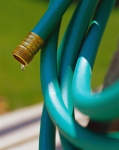(ARA) – You turn the faucet off when brushing your teeth and installed low-flow toilets and showerheads – but your outdated irrigation system could be undermining your efforts to save water.
The average American household uses 30 percent or more of its water outdoors in landscaping. Bigger users might be closer to 70 percent in some cases, according to the U.S. Environmental Protection Agency.
Some experts estimate that up to half of the water used to irrigate landscapes is wasted due to evaporation, wind or runoff caused by poorly adjusted sprinklers, improper design or overwatering.
Summer is the time when water use spikes the most and is the reason why the Irrigation Association dubbed July “Smart Irrigation Month.” Saving water doesn’t have to be complicated; you can find water efficient choices to accommodate any budget.
Smart products: water less, save more
Like cell phones, video games and cars, irrigation technology has advanced dramatically in the past 10 years. You can do more with the irrigation technologies of today. Consider adding these water-saving devices to your irrigation system:
* High-efficiency nozzles: Replace conventional spray heads with high-efficiency nozzles to apply water more evenly and reduce your landscape water use by 30 percent.
* Rain/moisture sensors: Sensors will override an irrigation controller to turn off the system at the first detection of rainfall or the presence of moisture in the soil.
* Low-volume drip irrigation: Drip irrigation systems reduce water use by applying only the required amount of water directly to the plant, minimizing evaporation and water waste.
* Smart controllers: These controllers take into account weather conditions, soil type, plant material and other factors to automatically adjust irrigation system run times to deliver only what is necessary, conserving thousands of gallons of water annually.
* Rainwater harvesting: The collection of just 1 inch of rainfall on an average roof is enough to provide more than 500 gallons of reusable water. Capturing and storing water for reuse in the landscape is easy using belowground catchments or aboveground cisterns or barrels.
* Pressure regulated valves or sprinkler heads: A five-point reduction in psi (a standard measure of water pressure in your irrigation system) can reduce water use by 6 to 8 percent. Proper system pressure also improves performance and life expectancy.
Don’t overlook the simple solutions that can help save water, such as watering in the early mornings when winds are calm and temperatures are cool, and properly adjusting your sprinklers to prevent sidewalk watering.
Getting started
It is important to ensure your choices are the right choices for your landscape. The right products, combined with proper management techniques, will help your landscape look its best while saving water and money.
Before you run out and buy a new smart controller, you should consider a few things to help you get started:
* Check for leaks. The EPA reports that an irrigation system leak about the thickness of a dime can waste about 6,300 gallons of water per month. Fixing leaks can reduce water use by more than 10 percent.
* Check for local rebate programs. Many water agencies offer rebate programs for water efficient products, so check with your local water provider to see if they offer product discounts or free products.
* Consult a professional. Hire a certified landscape irrigation auditor to visit your home and conduct a site inspection and water audit to determine water-wasting inefficiencies. An auditor will provide a results report that lists opportunities for irrigation system upgrades or repairs. Or, hire a certified irrigation contractor or designer to talk with you about the best water-saving technologies for your landscape.
* Plant choices. Know the water needs of the different plants in your landscape, and give each plant just the right amount; this is the key to a healthy landscape that uses less water. When possible, choose plants with low water use requirements. Check with your local water agency to obtain a recommended plant list for your region, or spend a few minutes on the Internet. You may be surprised by how many beautiful native plant choices are available.
For more tips on how you can use less water in your landscape all year long, visit the Irrigation Association’s Smart Irrigation Month website at www.irrigation.org/SIM.


